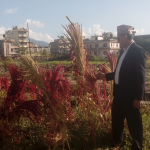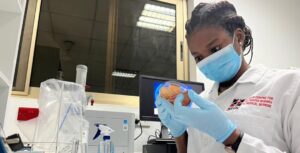Conservation agriculture leads to remarkable improvement in crop production and livelihood of farmers in Bangladesh
Bangladesh, one of the densest countries in terms of population with about 1000 people living per square kilometre, has always been under huge pressure to feed its growing population. Intensive agricultural practice, which involves mono-cropping and use of chemical fertilizers and pesticides, helped boost productivity initially. However, these approaches involved little or no replenishments of used up organic matter and so generations of unsustainable farming methods have resulted in deterioration of soil quality.
A recent research article that appears on Bangladesh Journals Online, established with support from INASP, shows that giving up unsustainable farming and adopting methods of conservation agriculture is beneficial both for the environment and the farmer’s livelihood.
The research on Conservation agriculture practice and its impact on farmers’ livelihood status in Bangladesh conducted in Mymensingh, Bogra, Tangail, Sherpur and Jamalpur districts by M. T. Uddin and A. R. Dhar of the Department of Agricultural Economics, Bangladesh Agricultural University, Bangladesh found a remarkable improvement in crop production and livelihood of farmers after adopting conservation agriculture practice. The cost had gone down, and production risen resulting in an increased profit.
According to the research article, conservation agriculture is the practice of applying resource-saving techniques ensuring minimum mechanical soil disturbance, permanent organic soil cover and diversified crop rotations to achieve optimum profit from minimum possible cultivation cost while conserving the environment at the same time.
Despite the benefits of conservation agriculture like increased productivity and income, reduced working time, high water and energy efficiency, and conservation of the natural environment only a small proportion (8-10%) of global farmers follow this practice.
In the study conducted among 300 farmers of the region to assess the livelihoods of farmers practising conservation agriculture against those not practising it, 50 farmers practising conservation agriculture (focal farmers) were found have significantly increased their income and improved livelihood compared to the 150 (control group) farmers who did not adopt conservation agriculture. The livelihood and production of the 100 farmers (proximal) living nearby the focal group and thereby learning and adopting conservation agriculture practices partially had better livelihood and production than the control group, but not as good as that of the focal group.
“Cost of crop production was relatively lower and return from production was comparatively higher in conservation agriculture practice than conventional agriculture practice,” reports the research article. “Farmers’ income was increased and expenditure was decreased through adopting conservation agriculture practice.”
The research showed that focal group farmers had followed the three main principles of conservation agriculture – minimum tillage, retaining crop residue and practicing crop rotation.
The focal group farmers had also followed other principles of conservation agriculture such as using compost manure, vermi-compost, cow dung, bio-slurry and Integrated Pest Management (IPM) technology. They did not use any synthetic pesticides and herbicides and kept the use of synthetic fertilizers to a minimum.
Proximal farmers had practised some of these techniques, while the control group farmers did not practise any of the conservation agriculture techniques and instead used synthetic fertilizers, pesticides, herbicides and medicine.
The research findings show that conservation practice is the best approach to follow for both soil and environment conservation and poverty reduction. The practice is also suitable because most of the farmers in Bangladesh are small holder farmers with landholding of less than a hectare.
According to the research article, “poverty in terms of deprivation of health, education and living standards was decreased; and overall livelihood circumstances were improved adopting conservation agriculture practice”.
The farmers not only increased their production but also fetched better prices at the market as their products were chemical free. The authors have made some policy recommendations including input support, motivation and extension services from the government to raise awareness about practising conservation agriculture.
“Also, initiative for scientific and technical training programmes should be arranged by different government and non-government organizations to enrich the knowledge of the farmers on conservation agriculture practice,” recommends the article.
Article details
Uddin, MT and Dhar, AR, Conservation agriculture practice and its impact on farmers’ livelihood status in Bangladesh, SAARC Journal of Agriculture, Vol. 14 No 1, 2016, pages 119-140.
About the Journal
SAARC Journal of Agriculture is an international, half-yearly peer-reviewed open-access online journal that publishes original research articles, review papers and short communications in the fields of agriculture, animal sciences, fisheries, natural resources management and allied disciplines. It is an official journal of SAARC Agriculture Centre (SAC). The scientists and researchers from SAARC countries are encouraged to submit their research and review papers for publishing in this journal.
About BanglaJOL
BanglaJOL is a database of journals published in Bangladesh. It was initiated in June 2007 and officially launched in September 2007 with the support of by International Network for the Availability of Scientific Publication (INASP). The objective of BanglaJOL is to give greater visibility to the participating journals, and to the research they convey. It is managed locally by the Bangladesh Academy of Science (BAS). It provides open access to the full text of research articles published in 139 different journals from a wide range of academic disciplines and genres.
About INASP
INASP is an international development charity working with a global network of partners to improve production, sharing and use of research information and knowledge, so that countries are equipped to solve their development challenges. In particular, INASP works to strengthen the availability, access and use of international research information by researchers in developing countries and the production, quality, dissemination and access of research outputs from researchers in those same countries.
Disclaimer: Research published in journals hosted on the BanglaJOL platform is selected by the journals in accordance with their own editorial processes and criteria. INASP and BanglaJOL provide hosting and guidance on good practices but are not involved in selection of research.
For Further Information
Thakur Amgai, Communications Consultant, INASP
email tamgai@inasp.info
Dr Sangita Shrestha, Communications Officer, INASP
email sshrestha@inasp.info

 Previous Post
Previous Post Next Post
Next Post


